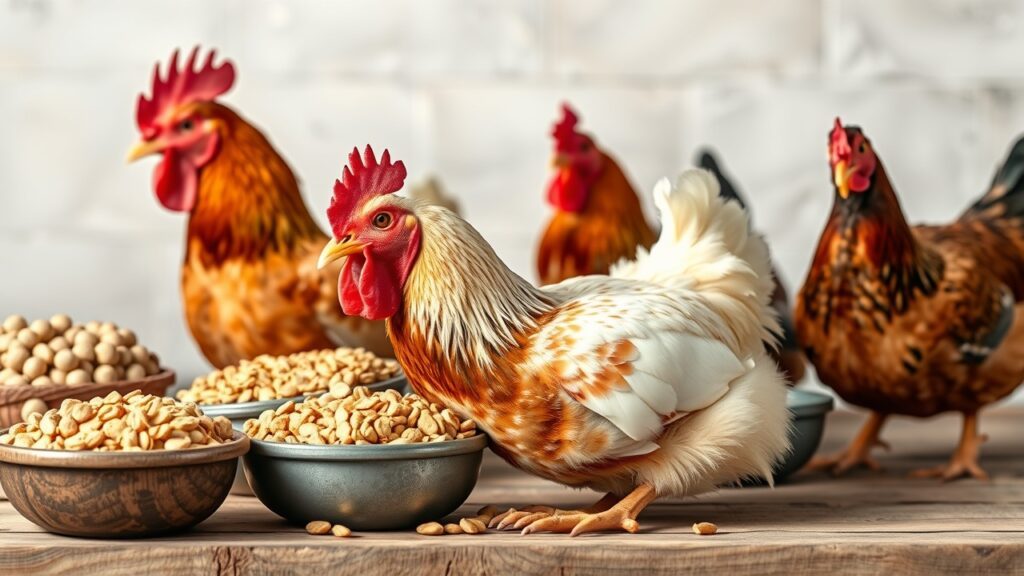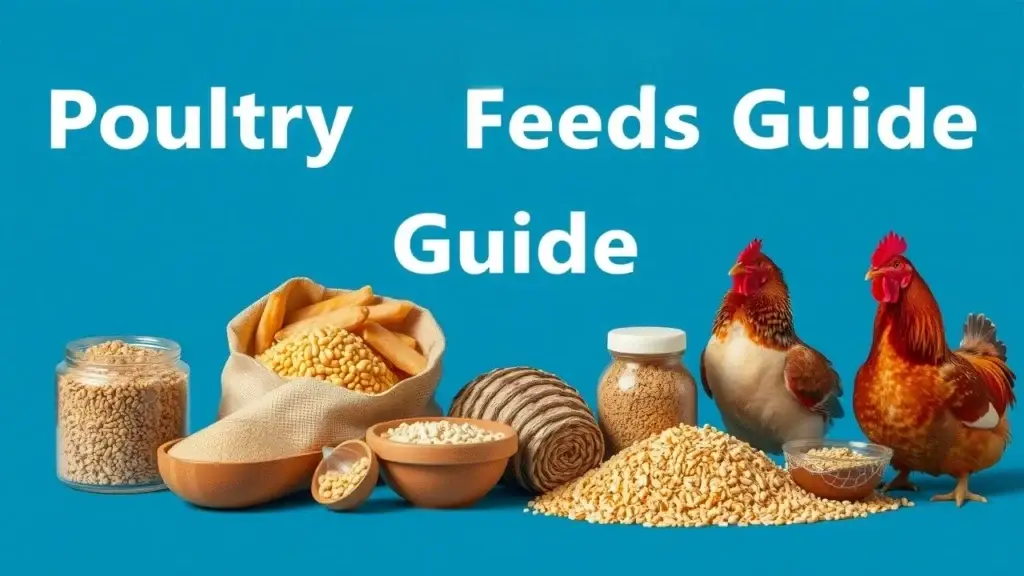Types of poultry feeds vary by bird age and purpose. This guide covers chicken, broiler, and layer diets, including feed ingredients and nutritional needs.
What Are Poultry Feeds?

Poultry feeds are mixes made to give chickens and other birds the right nutrition. They have many ingredients that provide proteins, carbs, vitamins, and minerals. The main job of poultry feed is to keep birds healthy and productive. This means they need what it takes to grow well, lay eggs, and have good meat quality.
Feeding the birds correctly is very important for their health. A balanced diet helps avoid problems like diseases or poor growth. For example, hens need certain nutrients to lay good eggs every day, while broilers need a special mix to gain weight quickly. Knowing these needs helps you get the best results from your flock.
Why Is Choosing the Right Feed Important?
Picking the right poultry feed affects many parts of raising birds. Good nutrition helps them grow faster and stay healthy. When chickens eat well, they can lay more eggs or gain more weight.
On the flip side, feeding them wrong can cause big issues for their health and your profits. Birds without enough nutrients may get sick or grow slowly. This not only hurts individual birds but can also lead to lower overall yields for farmers.
Another key point is understanding feed conversion ratios—the amount of feed needed for each pound gained. This ratio helps farmers see how efficient their feeding methods are. By using the right feeds that meet specific nutritional needs, farmers can improve animal welfare and make more money from their operations.
Types of Poultry Feeds by Life Stage
Starter Feed Explained
Starter feed, or chick feed, is super important for young poultry. This feed has a high protein content of 20% to 24%, perfect for chicks aged 0 to 6 weeks. It provides essential nutrients that help chicks grow fast and healthy. Key ingredients include amino acids like lysine and methionine, which are crucial for muscle development.Chicks have different nutritional needs compared to adult birds. Starter feeds give them the right mix of proteins, vitamins, and minerals they need at this stage.
When Should You Use Starter Feed?
You should start feeding starter feed right after the chicks hatch or when you bring them home. Keep giving it to them until they are about six weeks old. During this time, feeding methods can differ. Some farmers use feeders that let chicks eat easily while keeping waste low. A good chicken nutrition plan in these early weeks helps ensure healthy adults later on.
Grower Feed Overview
Grower feed is designed for chickens moving from starter food into adulthood. This feed usually has moderate protein levels between 18% and 20%, suitable for birds aged around six weeks to four months old. The focus is on steady growth without giving too much energy or calcium. As chickens grow up, their diets need to change quite a bit compared to when they were younger. Grower feeds help keep their diets balanced based on their growth stages.
How Long Do Chickens Stay on Grower Feed?
Chickens stay on grower feed until they reach maturity, usually around four months old. After that, they switch to finisher or layer feeds based on whether they’re raised for meat or eggs. It’s important to keep an eye on their weight and health during this time to know when it’s time for a feed change.
Finisher Feed Essentials
Finisher feed is meant for mature birds that are getting close to slaughter age or starting to lay eggs. This feed typically has lower protein levels, around 16% to 18%. The goal here is to help with weight gain before processing or ensuring hens get enough nutrition as they prepare to lay eggs.This kind of feed helps broiler chickens gain weight effectively while keeping them healthy before they’re ready for market.
Best Time to Introduce Finishing Formulations
You should introduce finisher formulations once your broilers are about six weeks old if you’re raising them just for meat. Layers may stay on grower diets longer depending on individual needs tied directly to their egg-laying cycles in different breeds used in poultry farming today.
Comparison
Key Nutritional Differences
Each type of poultry feed serves a specific purpose based on the life stage or production goal of the birds:
- Starter Feed: This is for chicks up to six weeks old. It has high protein levels (20%-24%) to support rapid growth.
- Grower Feed: This is for birds from six weeks until they reach market weight or start laying eggs. It usually has moderate protein levels (16%-20%) and balanced energy.
- Finisher Feed: Used just before slaughter, it focuses on maximizing weight gain with lower protein content (14%-18%) but higher energy values.
- Layer Chicken Feed: Made for hens that are laying eggs, it includes higher calcium levels (up to about 3%) which are necessary for strong eggshells along with adequate protein.
- Breeder Feeds: These can vary widely depending on whether they’re intended for broilers or layers but generally provide nutrients that promote reproductive health in breeding stock.
The differences in these feeds affect bird health and production outcomes at each life stage by ensuring that their nutritional needs are met—whether it’s promoting growth in young chicks or enhancing egg production in layers through proper mineral balance like calcium and phosphorus percentages.
By understanding these distinctions among types of poultry feeds, farmers can make informed decisions tailored to their flock’s needs based on age or purpose—whether for meat production or egg laying.
Choosing the Right Feed: Factors to Consider
Choosing the right feed for your poultry is very important. The health and productivity of your birds depend on it. Knowing about different types of poultry feeds can help you make better choices.
Factors Influencing Feed Selection
When picking out poultry feed, several key factors come into play:
- Bird Age: Chickens have different nutritional needs at various ages. Starter feeds are best for chicks because they need proteins and vitamins to grow strong. For layers, a diet high in calcium is necessary for good egg production, while broilers benefit from high-energy foods that help them grow quickly.
- Breed Type: Each breed has special dietary needs. For example, laying hens usually require more protein than meat birds like broilers, which need energy-rich foods to gain weight efficiently.
- Production Goals: What are your goals? Are you raising chickens for eggs or for meat? This choice affects your feed selection. Layer feeds have more calcium and less protein compared to broiler feeds, which focus on muscle growth.
- Health Considerations: Keeping an eye on the health of your flock is crucial. If you see any signs of sickness, you might need to change their diet to ensure they get the nutrition they need and avoid disease outbreaks.
- Climate Impact: The weather can impact how well birds absorb nutrients and their energy needs. In colder weather, birds may need extra calories to stay warm, while in hot conditions, their appetite might drop, requiring a shift in feeding strategy.
- Budget Constraints: Cost matters when choosing between commercial feed options and homemade recipes for chicken feed formulation. Finding a balance between quality nutrition and affordability is key.
Expert Consultation
Talking with professionals like veterinarians or experienced farmers can provide helpful insights tailored to your flock’s unique needs. Regularly analyzing the feeds you choose helps make sure they meet the changing nutritional demands of your chickens over time.
Best Practices for Poultry Feed Management
Feed Storage and Handling
Keeping poultry feed stored properly is super important. It helps maintain the quality and nutrition of the feed. If feed isn’t stored right, it can spoil, which wastes money and can hurt your birds’ health. Store poultry feed in a cool, dry place away from sunlight to keep the right temperature and humidity levels. To stop spoilage, use airtight containers. These keep moisture and pests out. Regularly check for signs of mold or insects in the feed. If you see any problems, throw out the bad parts right away. Keeping the storage area clean is also key to keeping pests away. You also need to keep feeders and waterers clean. Dirty feeders can make your flock sick by harboring bacteria. Clean them often with hot soapy water and rinse them well to remove any leftover soap.
Monitoring Bird Health
Daily checks on your birds are essential to catch signs of malnutrition or illness early. Watch for odd behaviors like lethargy or changes in how much they eat. You should also look for physical signs like feather loss or unusual droppings. Key signs to keep an eye on include growth rates and egg production. If growth slows down or if egg-laying drops, it might mean your birds aren’t getting enough nutrition. Sometimes you might need to change how you feed based on what you see during your checks. For example, if some birds seem underweight or have poor feather quality, try giving them a diet higher in protein or adding supplements that meet their specific needs. By following these best practices for poultry feed management and monitoring bird health closely, small-scale poultry farmers can help ensure their flocks stay healthy and productive while making the most of their resources.
Making Your Own Poultry Feed
Making homemade poultry feed can be a fun and cost-saving choice for small farmers and backyard chicken owners. However, it helps to think about the good and bad sides before getting started.
Pros of Homemade Feeds
- Cost-Effective: Often, homemade feeds can be less expensive than buying them at the store. If you have local grains or kitchen scraps, you can save money.
- Control Over Ingredients: You decide what goes into your feed. This means you can use high-quality ingredients that meet your birds’ needs without any unwanted extras.
- Customization: You can adjust the feed recipe based on your chickens’ age, breed, and purpose—whether they’re layers or broilers.
Cons of Homemade Feeds
- Nutritional Balance Challenges: It can be hard to make sure the diet is balanced. If not done right, your birds might miss out on important nutrients.
- Time-Consuming: It takes time to gather ingredients and mix everything correctly.
- Quality Control Issues: Without testing your feed, it’s tough to know if all the needed nutrients are in there.
To keep balanced chicken nutrition when making your own feed, here are some key parts:
| Ingredient Type | Nutritional Role |
|---|---|
| Grains | Main energy source |
| Protein Sources | Needed for growth and egg laying (e.g., soybean meal) |
| Vitamins & Minerals | Important for overall health (e.g., calcium for layers) |
When making homemade poultry feed recipes, always aim for a well-rounded nutrient profile suited to the type of poultry you raise—whether they’re layers or broilers—to help them stay healthy and productive.
Sourcing Ingredients for Homemade Feeds
Finding high-quality ingredients is key when preparing homemade poultry feeds. Here’s how to gather good stuff while keeping safety in mind.
Start by looking for trusted suppliers who sell fresh grains like corn or wheat at good prices. Local farms or grain co-ops usually offer quality products straight from producers, which keeps them fresh.
For protein sources:
- Soybean Meal – A top choice due to its high protein content; choose non-GMO options if you can.
- Fish Meal – Packed with omega fatty acids but make sure it’s from safe sources to avoid contamination.
- Insect-Based Proteins – These are becoming popular as eco-friendly choices; check local rules about using insects like black soldier fly larvae.
When picking any ingredient:
- Make sure it’s free from mold or harmful substances that could hurt your birds.
- Check expiration dates on things like vitamins and mineral mixes since they lose their effectiveness over time.
By focusing on quality when selecting ingredients—putting safety first—you’ll create effective supplemental poultry feed that meets your flock’s dietary needs while supporting their health through balanced nutrition strategies tailored specifically for different types of chicken feed available today!
Troubleshooting Picky Eating and Feed Wastage
Picky eating and feed wastage can be a big headache for poultry farmers. By figuring out what causes these issues, you can boost feed efficiency and give your chickens better nutrition.
Solutions for Common Problems
To tackle picky eating, look into these factors:
- Palatability of the Feed: Chickens may not eat if they don’t like the taste. Trying different poultry feed types could help you find what your flock enjoys.
- Texture (Pellet vs. Crumble): Some chickens prefer pellets, while others like crumbles or mash. Check which type your birds favor.
- Freshness of Ingredients: Stale or spoiled ingredients can make chickens refuse food. Always use fresh components in homemade feeds.
Now, let’s cut down on waste too:
- Feeder Designs: Choose feeders that limit spillage. This way, the feed stays clean and easy to access.
- Portion Sizes: Adjust how much you feed based on flock size and their eating habits to avoid overfeeding, which often leads to waste.
Preventative Measures
Regular health checks are important. Sick birds might skip meals due to feeling unwell rather than being picky. Keeping tabs on their health helps maintain their interest in food.
Rotating different types of feeds also keeps meals fresh and exciting for your flock. This not only helps with interest but also ensures they get a balanced diet with various nutrients from different poultry diets.
Pest Control in Homemade Feeds

Homemade poultry feeds offer flexibility but need careful management to prevent pests from ruining quality.
Storage Techniques
Good storage practices help maintain homemade feeds:
- Store homemade feeds in airtight containers to keep moisture out and avoid spoilage.
- Keep storage areas clean and free of debris that can attract pests like rodents or insects.
Preventative Strategies
Using natural deterrents can enhance protection against pests:
- Adding diatomaceous earth in storage bins acts as a natural pest control without harmful chemicals.
- Regularly check stored ingredients for signs of pests or contamination, making sure to discard anything affected before it spreads to other supplies.
Sourcing Commercial Poultry Feed
Finding the right commercial poultry feed is key for small farmers and backyard chicken lovers. The market has many poultry feed types that cater to layers, broilers, and specialty breeds. Choosing the best feed matters because it affects your birds’ health and productivity.
Where to Purchase Commercial Feed?
You can buy commercial poultry feed from various places. Local agricultural supply stores usually have a range of brands and formulations for different birds. Here, you can ask staff about specific feeds.
Online retailers are popular for their convenience and variety. Many websites focus on farm supplies and include detailed product descriptions and customer reviews. This information helps you choose among the best poultry feed brands.
The cost of poultry feed can change based on the brand, ingredient quality, and whether it’s organic or not. It’s smart to compare prices at different stores before you buy.
Considerations for Organic and Specialty Feeds
Many farmers now prefer organic poultry feed. It’s made without synthetic pesticides or fertilizers, which is great if you care about animal welfare and the environment.
Non-GMO feeds are also popular among those who want to avoid genetically modified products. Using sustainable poultry feed benefits your chickens and helps the environment by reducing harmful runoff into local water systems.
Organic or specialty feeds might cost more than conventional ones, but many believe that supporting healthier farming methods is worth it. Plus, these feeds can improve egg quality or meat flavor.
FAQs About Types of Poultry Feeds
What types of poultry feed are available?
Poultry feed types include starter feed, grower feed, finisher feed, layer feed, and breeder feeds. Each type serves a different age and purpose.
What are common ingredients in poultry feeds?
Common ingredients in poultry feeds are corn, soybean meal, fish meal, wheat, and vitamins. These provide essential nutrients for birds.
How do nutritional needs vary among poultry?
Nutritional needs vary by age and purpose. Chicks need high protein for growth, while layers require more calcium for egg production.
What are the advantages of using organic poultry feed?
Organic poultry feed avoids synthetic chemicals. This promotes healthier birds and can enhance meat or egg quality.
Can I make my own poultry feed at home?
Yes, you can make homemade poultry feed. It allows you to control ingredients and save costs but requires careful formulation for balanced nutrition.
Additional Insights on Poultry Feed Types
- Poultry Feed Additives: Use premixes to boost nutrition with vitamins and minerals.
- Feed Processing: Explore methods like pelleting or crumbling to improve digestibility.
- Feed Storage Solutions: Store feed in airtight containers to prevent spoilage.
- Cost Considerations: Compare prices between commercial and homemade feeds for savings.
- Poultry Nutrition Analysis: Regularly analyze feeds to ensure they meet the nutritional requirements of your flock.
- Protein Sources for Poultry: Consider adding insect-based proteins or mealworms to enhance protein content.
- Balanced Poultry Diets: Combine grains, protein sources, vitamins, and minerals for a complete diet.
- Feeding Methods: Evaluate feeder types to minimize waste and maximize feeding efficiency.
These points cover various aspects of poultry feeds and their management while ensuring a comprehensive understanding for small-scale farmers.
Related Topics
- Types of poultry feed ingredients
- Types of poultry feed by life stage
- Types of feeders for poultry
- Types of poultry feed storage solutions
- Types of protein sources for poultry
- Types of poultry feed additives
- Types of pest control for poultry feed
- Types of commercial poultry feed
- Types of organic poultry feed
- Types of non-GMO poultry feed
- Types of homemade poultry feed recipes



Types of Poultry Feeds: A Complete Guide